Journal of Yoga & Physical Therapy
Open Access
ISSN: 2157-7595
+44 1478 350008
ISSN: 2157-7595
+44 1478 350008
Research Article - (2012) Volume 2, Issue 2
In this article the author argues that complete presentation of Stress is neither Possible nor desirable as stress is an important stimulus of human growth and creativity as well an inevitable part of life.
Stages of stress
Stress is a Sudden Biological Change. It has become the curse of 21st century and is silent killer in the modern world. Stress is the greatest danger to the information era. Stress is the priceless poison for human life in the universe. It can disturb any one’s physical, mental, emotional and behavioral balance. Stress can damage different parts of human body from muscles from tissues to organs and blood vessels. It can speed up pulse rate and respiration. It can raiseblood pressure and body temperature. It can also interfere with the body metabolism, digestion, appetite, sleep, sexuality and even fertility. Occupational stress includes the environmental factors or stressors such as work overload, role ambiguity, role conflict and poor working conditions associated with a particular job [1].
There are three stages a person goes through while suffering from stress. Know more about them.
Alarm stage
This stage experiences an over acting of the sympathetic nervous system wherein adrenaline and cortisol increase and blood flows away from the brain to the muscles. As a result, dendrites shrink back in the brain to moderate the flow of information, slowing or closing down the nonessential body functions. The whole body starts preparing itself to fight against the reason of stress. The fear, excitement or pressure is evident on the sufferer’s face.
Resistance stage
In this stage, the body keeps making continuous efforts to cope with stress and therefore feels run down and the person starts feeling irritated, over reacts to minor situations and gets mentally and physically weak. Psychological, physical and behavioral changes are also clearly visible.
Exhaustion stage
If a student is preparing for his exam and despite of every possible effort, he is not able to relate to his studies, he is bound to get stressed. The stress could reach a height where he/she may feel completely exhausted and helpless to the extent of committing suicide. This is the exhaustion stage. This stage is further divided into two phases: The nature of stress is broadly of two types- Eustress (Positive stress, Distress (Negative stress).
The positive effects of pressure: Sometimes, however, the pressures and demands that may cause stress can be positive in their effect. One example of this is where sportsmen and women flood their bodies with fight-or-flight adrenaline to power an explosive performance. Another example is where deadlines are used to motivate people who seem bored or unmotivated. We will discuss this briefly here, but throughout the rest of this site we see stress as a problem that needs to be solved.
The negative effects of pressure: In most work situations jobs, our stress responses cause our performance to suffer. A calm, rational, controlled and sensitive approach is usually called for in dealing with most difficult problems at work: Our social inter-relationships are just too complex not to be damaged by an aggressive approach, while a passive and withdrawn response to stress means that we can fail to assert our rights when we should.
If exposure to stressors continues for a longer period of time, chronic health problems can develop, such as:
Psychological and emotional
• Feeling heroic, invulnerable, euphoric
• Denial
• Anxiety and fear
• Worry about safety of self and others
• Anger
• Anger
• Irritability
• Restlessness
• Sadness, grief, depression, moodiness
• Distressing dreams
• Guilt or “survivor guilt”
• Feeling overwhelmed, hopeless
• Feeling isolated, lost, or abandoned
• Apathy
• Identification with survivors
Cognitive
• Memory problems
• Disorientation
• Confusion
• Slowness of thinking and comprehension
• Difficulty calculating, setting priorities, making decisions
• Poor concentration
• Limited attention span
• Loss of objectivity
• Unable to stop thinking about the disaster
• Blaming
Behavioral
• Change in activity
• Decreased efficiency and effectiveness
• Difficulty communicating
• Increased sense of humor
• Outbursts of anger, frequent arguments
• Inability to rest or “letdown”
• Change in eating habits
• Change in sleeping patterns
• Change in patterns of intimacy, sexuality
• Change in job performance
• Periods of crying
• Increased use of alcohol, tobacco, or drugs
• Social withdrawal, silence
• Vigilance about safety or environment
• Avoidance of activities or places that trigger memories
• Proneness to accidents
Physical
• Increased heartbeat, respiration
• Increased blood pressure
• Upset stomach, nausea, diarrhea
• Change in appetite, weight loss or gain
• Sweating or chills
• Tremors (hands, lips)
• Muscle twitching
• “Muffled” hearing
• Tunnel vision
• Feeling uncoordinated
• Headaches
• Soreness in muscles
• Lower back pain
• Feeling a “lump in the throat”
• Exaggerated startle reaction
• Fatigue
• Menstrual cycle changes
• Change in sexual desire
• Decreased resistance to infection
• Flare-up of allergies and arthritis
• Hair loss
Yoga is most Recognized form of Exercise, Stretching, Aerobic exercise and Meditation. The definition of yoga is “to yoke or joint together” [2] it integrates the mind and body focusing on balance posture, deep breathing, stretching and relaxation. Yoga evolved from of the Hindu, Jaina, and Buddhist religious traditions in India. Yoga alters stress response and person’s attitude, towards stress along with improving self confidence, increasing one’s sense of well being, and creating a feeling of relaxation and calmness [3].
Yoga is an ancient art that is defined as the union of the soul with God [4]. It is “a path of personal spiritual development that utilizes meditation to bring enlightenment, self-realization, and, ultimately, the attainment of God and bliss” . Originally, the ultimate goal of yoga was called Samadhi, or self-realization [5].
Patanjali is father of yoga around the sixth century B.C. appeared in the massive epic The Mahabharata written by sage Vyasa and containing The Bhagavad Gita. Krishna explains to Arjuna about the essence of Yoga as practiced in daily lives (‘Song of the Lord’), uses the term “yoga” extensively in a variety of ways. In addition to an entire chapter dedicated to traditional yoga practice, including meditation, it introduces three prominent types of yoga:
Karma yoga: The yoga of action
Bhakti yoga: The yoga of devotion, note Krishna had also specified devotion itself was action similar to above.
Jnana yoga: The yoga of knowledge.
Patanjali introduced -Ashtanga or Power yoga - a more demanding workout where you constantly move from one posture to another (“flow”).The dimensions of yoga are
• Pranayama (breathing)
• Asana (postures)
• Yama (restraint)
• Niyama (healthy observances)
• Pratyahara (sensory withdrawal)
• Dharana (concentration)
• Dhyana (meditation)
• Samadhi (higher consciousness)
Types of Asanas (postures)
They work at the chitta (subtle aspect of consciousness) level that eliminates the physical and mental tensions. They are trained in supine and prone position of the body respectively. Shavasana and Makarasana, Vijrasana, Bhujangasana, Trikonasana, Virabdrasana, Pranayama, Siddhasana with Kumbhaka, Padmasana, Yogamudras are important relaxative asanas (Figure 1).

Vajrasana
Vajrasana is best asana of Stress & Tension and Anxiety it makes the body exceptionally strong and healthy. Vajra means Diamond in Sanskrit. During this asana, feel the sensations in the body as you move them. Do the Movement slowly and in a relaxed manner. Inhale and exhale slowly. While drawing the abdominal region inwards and expanding the chest, focus the attention on these body parts. The way the muscles move must be felt. Relax before, during and after the yoga posture.
1. With knees, ankles and big toes touching the ground, take a kneeling position.
2. One should sit on the heels and place palms on the knees.
3. The Spine should be erect and breath should be deep.
4. Draw the abdominal region inside and expand the chest (Figure 2).
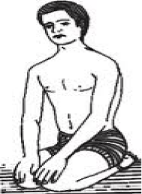
The triangle pose – Trikonasana
The legs are spread apart and the body stretches to the left, moving from the pelvis and extending over the left leg. Both arms are perpendicular to the floor, the left hand on the floor, or resting on the calf or the outer ankle of the left foot, and the right hand reaching up straight. The spine is straight, chest open, the body facing to the front (Figure 3).
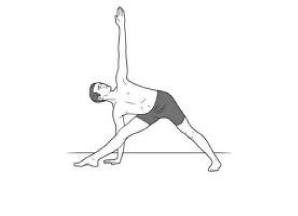
The cobra pose - Bhujangasana
The pose starts from a downward facing position with hands flat on the floor below the shoulders. The spine is lengthened and the buttocks firmed as the head and chest is slowly lifted. The elbows stay close to the body and the eyes look up. The neck is kept neutral (Figure 4).
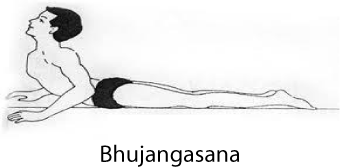
The warrior pose - Virabhadrasana
From a standing position, feet are jumped apart approximately 4 feet. Arms are raised parallel to the floor, gaze is forward. Left foot is turned 90 degrees to the left and the knee is bend (keeping the knee above the ankle) (Figure 5).
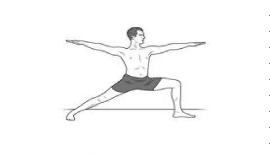
Padmasana
`
1. Sit on the ground by spreading the legs forward.
2. Place the right foot on the left thigh and the left foot on the right thigh.
3. Place the hands on the knee joints.
4. Keep the body, back and head erect.
5. Eyes should be closed.
6. One can do Pranayama in this asana (Figure 6).
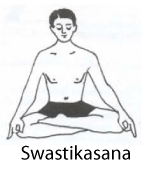
Siddhasana
1. Place the left heel at the anus, the terminal opening of the alimentary canal or digestive tube.
2. Keep the right heel on the root of the generative organ.
3. It should be in a way that the knees and the heels, both lie upon the other.
4. The hands must be placed on either sole of the feet. Keep the eyes half closed (Figure 7).
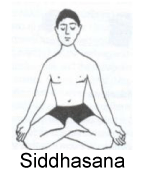
Breathing exercise
Pranayama, the breathing exercise, may rejuvenate you, to carry on your work with extra energy.
1. Put your right thumb on your right nostril
2. Deeply inhale air using your left nostril
3. Close your left nostril with your right index finger and hold breath for few seconds
4. Exhale through left nostril
5. Do it similarly with left nostril closing right nostril
6. Now inhale through left nostril, hold breath and exhale through right nostril and do the other way (Figure 8).

Neck roll
Neck-roll exercises can ease tension in the neck region and normalize the situation
• Turn the head to the right and back to normal. Then turn to the left and back to normal.
• Bend the head to the left as if you are pulling the left ears to the left shoulder. Then bend to the right as if pulling the right ears to the right shoulder.
• Rotate the neck slowly to the left and then to the right (also known as Brahma mudra) Depending upon the ailments, one can practice asanas (Figure 9).
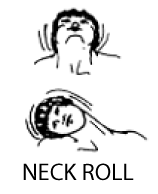
Mental calmness
Yoga asana practice is intensely physical. Concentrating so intently on what your body is doing has the effect of bringing calmness to the mind. Yoga also introduces you to meditation techniques, such as watching how you breathe and disengagement from your thoughts, which help calm the mind.
Stress reduction
Physical activity is good for relieving stress, and this is particularly true of yoga. Because of the concentration required, your daily troubles, both large and small, seem to melt away during the time you are doing yoga. This provides a much-needed break from your stressors, as well as helping put things into perspective. The emphasis yoga places on being in the moment can also help relieve stress, as you learn not to dwell on past events or anticipate the future. You will leave a yoga class feeling less stressed than when you started. Read more about yoga for stress management here.
Body awareness
Doing yoga will give you an increased awareness of your own body. You are often called upon to make small, subtle movements to improve your alignment. Over time, this will increase your level of comfort in your own body. This can lead to improved posture and greater selfconfidence.
Actually yoga combines several techniques to combat stress. Yoga provides a combination of benefits such as breathing exercises, stretching exercises, fitness program, and meditation practice and guided meditations all in one technique. That is powerful, that is very powerful! Even for people who have physical limitations yoga can be very beneficial just by practicing the breathing techniques, the meditation and the guided meditation. Just by doing this you can have great benefits with the practice of yoga. So in conclusion yes yoga can be a great remedy for stress and can offer some stress relief. Yoga has combined set of principles and exercises that can greatly benefit you and help you to deal with stress.